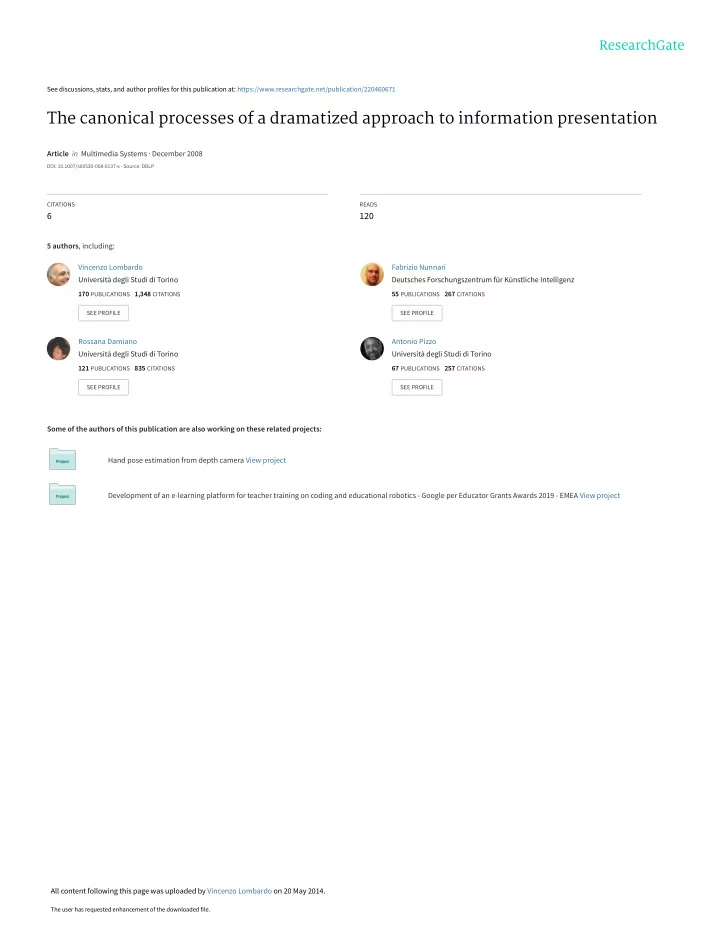

See discussions, stats, and author profiles for this publication at: https://www.researchgate.net/publication/220460671 The canonical processes of a dramatized approach to information presentation Article in Multimedia Systems · December 2008 DOI: 10.1007/s00530-008-0137-x · Source: DBLP CITATIONS READS 6 120 5 authors , including: Vincenzo Lombardo Fabrizio Nunnari Università degli Studi di Torino Deutsches Forschungszentrum für Künstliche Intelligenz 170 PUBLICATIONS 1,348 CITATIONS 55 PUBLICATIONS 267 CITATIONS SEE PROFILE SEE PROFILE Rossana Damiano Antonio Pizzo Università degli Studi di Torino Università degli Studi di Torino 121 PUBLICATIONS 835 CITATIONS 67 PUBLICATIONS 257 CITATIONS SEE PROFILE SEE PROFILE Some of the authors of this publication are also working on these related projects: Hand pose estimation from depth camera View project Development of an e-learning platform for teacher training on coding and educational robotics - Google per Educator Grants Awards 2019 - EMEA View project All content following this page was uploaded by Vincenzo Lombardo on 20 May 2014. The user has requested enhancement of the downloaded file.
The canonical processes of a dramatized approach to information presentation Fabrizio Nunnari Vincenzo Lombardo Rossana Damiano ASA-Lab/VRMMP CIRMA and VRMMP CIRMA c.so Lombardia 194 Università di Torino Università di Torino 10149 - Torino, Italy c.so Svizzera 185 c.so Svizzera 185 fnunnari@vrmmp.it 10149 - Torino, Italy 10149 - Torino, Italy vincenzo@di.unito.it rossana@di.unito.it Antonio Pizzo Cristina Gena CIRMA CIRMA Università di Torino Università di Torino via S. Ottavio 20 c.so Svizzera 185 10123 - Torino, Italy 10149 - Torino, Italy antonio.pizzo@unito.it cgena@di.unito.it This paper describes the application “Carletto the spider” in the emotions displayed by the characters [11]. The emo- in terms of the mapping with the canonical process of me- tions of a character result from the conflicts she/he engages dia production. “Carletto the spider” is a character-based with her/himself or with other external entities during the guide to a historical site and implements the Dramatour drama performance. In a plot designed by a drama author, approach for the design of drama-based interactive presen- such conflicts increase in number and intensity until they tations. Dramatization makes presentations more engaging, find some resolution [9]; so, the drama features a rising then thus improving the reception of the content by the user. The falling emotional course (often called dramatic arc [4]). major technical issue of the approach is the segmentation of the presentation into audiovisual units that are edited on- Differently from linear (non-interactive) drama, the author the-fly in a way that guarantees dramatic continuity while of an interactive dramatic plot must accommodate the reac- adapting to the user response. We describe the workflow of tions of the user, and manage the interferences arising from the application and its mapping to the canonical processes of the interaction between the user’s reactions and the emo- media production, envisaging possible standardizations for tional course of the plot. The solution is to employ some the application portability. form of flexible drama scripting [8]. In the simpler case of single-character interactive presenta- 1. INTRODUCTION tions for visit guidance to a historical location, such as the This paper describes the implemented application “Carletto case of“Carletto the spider”, the users’ (in our case, visitors) the spider” in terms of the canonical processes of media pro- reactions are limited to the implicit or explicit manifesta- duction [7]. “Carletto the spider”presents information about tion of different degrees of interest for the topic addressed a historical site in a dramatized form. The presentation is by the presentation at some point. Her/his input influences delivered by a virtual character, adapting the content to the the subsequent selection of topics operated by the character user’s location on–the–fly. “Carletto the spider” is an ex- and the way they are presented. The presentation is seg- ample of the Dramatour approach for building drama-based mented into atomic audiovisual units, annotated according information presentations [2]. to the topic they deal with, and assembled on–the–fly in response to the user’s input to form a presentation that is The Dramatour approach merges production methods for compliant with the drama tenets sketched above. The char- dramatic media [3], such as television or cinema, and for- acter’s presentation must address both the task of providing mal annotation techniques to build information presenta- information to the visitor and the task of building a bond tions. The assumption underlying the methodology is that with the visitor for emotional engagement. the dramatization of the exposition enhances the effective- ness of the communication through the user’s engagement In the next section we describe how we have developed the application “Carletto the spider”; then, we operate the map- ping with the canonical processes; finally, we provide some conclusions. 2. THE MAKING OF “CARLETTO THE SPI- DER” The application “Carletto the spider” is a virtual guide for conf name, location the historical location of Palazzo Chiablese in Torino, Italy.
Recommend
More recommend